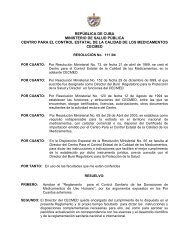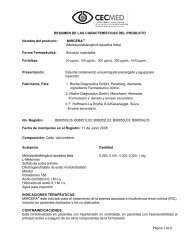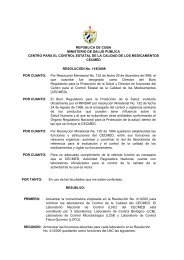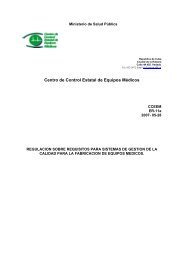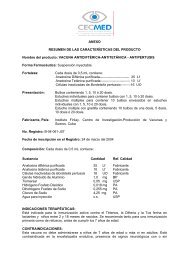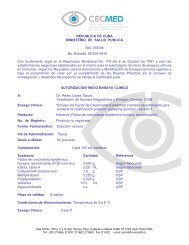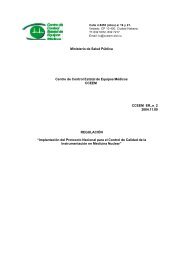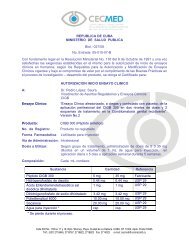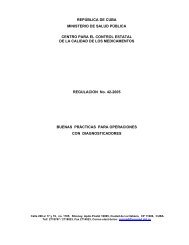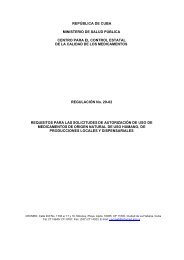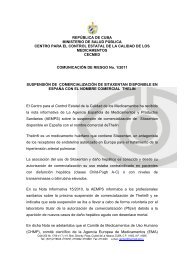AC 2005 Vol-1.pdf - Cecmed - Infomed
AC 2005 Vol-1.pdf - Cecmed - Infomed
AC 2005 Vol-1.pdf - Cecmed - Infomed
You also want an ePaper? Increase the reach of your titles
YUMPU automatically turns print PDFs into web optimized ePapers that Google loves.
22<br />
Revisión sobre el factor...<br />
Consideraciones costo-beneficio<br />
El G-csf es una droga costosa. El costo<br />
para una dosificación de 10 días para la<br />
prevención de la neutrofília febril después<br />
de una quimioterapia de cáncer se estima<br />
en el orden de $1283.60 para 10 viales<br />
(263 microgramos/vial). Este es el costo<br />
estimado, ya que esto fluctúa acorde con<br />
los distintos fondos de seguro médico.<br />
[45]. El G-csf ofrece seguridad al apoyo<br />
hematológico de los pacientes con cáncer<br />
que reciben quimioterapia, pero no<br />
constituye un tratamiento anticáncer. El<br />
uso del G-csf permite a los pacientes<br />
recibir la dosis programada de<br />
quimioterapia sin reducción de la misma, e<br />
incluso, un incremento de estas dosis<br />
protegiendo a los pacientes de algunos de<br />
los efectos hematológicos mencionados<br />
anteriormente [46].<br />
Conclusiones<br />
El G-csf no es solo una citoquina dirigida<br />
a neutrófilos, sino también estimula la<br />
proliferación y actividad de neutrófilos.<br />
Esto tiene influencia sobre los monocitos y<br />
linfocitos y limita el potencial proinflamatorio<br />
de los mismos. Dado su<br />
potencial anti-inflamatorio y la mejor<br />
defensa anti-bacteriana de los neutrófilos<br />
el G-csf ofrece un perfil farmacodinámico<br />
único. Bioensayos con mayor<br />
especificidad para esta citoquina y nuevas<br />
aplicaciones clínicas están en fase de<br />
desarrollo.<br />
Referencias Bibliográficas<br />
[1] Demetri GD, Griffin JD. Granulocyte colonystimulating<br />
factor and its receptor. Blood, 78-<br />
2791-808, 1991.<br />
[2] Burgess A, Metcalf D. Characterization of a<br />
serum factor stimulating the differentiation of<br />
myelomonocytic leukemia cells. Int. J. Cancer,<br />
26, 647-54, 1980.<br />
[3] Nicola NA, Metcalf D, Matsumoto M, Johnson<br />
GR. Purification of a factor inducing<br />
differentiation in murine myelomonocytic<br />
leukemia cells. Identification as granulocyte<br />
colony-stimulating factor. J. Biol. Chem 258,<br />
9017-23, 1983.<br />
[4] Nicola NA. Granulocyte colony-stimulating<br />
factor In: Dexter TM, Garland JM Testa NG<br />
editors. Colony-stimulating factors. New York:<br />
Marcel Dekker, 77-109, 1990.<br />
[5] Oheda M, Hase, Ono M, Ikenaka T. Structures of<br />
the sugar chains of recombinant human<br />
granulocyte colony-stimulating factor produced<br />
by chinese hamster ovary cells. J. Biochem<br />
(Tokyo) 103, 544-6, 1988.<br />
[6] Welte KE, Platzer E, Lu L, Gabrilove J, Levi E,<br />
Mertelsmann R et al. Purification and biological<br />
characterization of human pluripotent<br />
hematopoetic colony-stimulating factor. Proc<br />
Natl Acad Sci USA, 82, 1526-30, 1985.<br />
[7] Nomura H, Imazeki, OhedaM, Kubota N,<br />
Tamura M, Ono M, eta al. Purification and<br />
characterization of human granulocyte colony<br />
stimulating factor (G-csf) EMBO J. 5, 871-6,<br />
1986.<br />
[8] Nagata S, Tsuchiya M, Asano S, Kaziro Y,<br />
Yamazaki T, Yamamoto O et al. Molecular<br />
cloning and expression of c-DNA for human<br />
granulocyte colony-stimulating factor. Nature,<br />
319, 415-8, 1986.<br />
[9] Le Beau M, Lemons R, Carrino J, Pettenati M,<br />
Souza L, Diaz M, Rowley J. Chromosomal<br />
localization of the human G-csf gene to 17q11<br />
proximal to the breakpoint of the (15,17) in acute<br />
promyelocytic leukemia. Leukemia, 1, 795-9,<br />
1987.<br />
[10] Simmers RN, Webber LM, Shannon MF, Garson<br />
OM, Wong G, Vedas MA et al, Localization of<br />
the G.csf gene on chromosome 17 proximal to<br />
the breakpoint in the t(15,17) in acute<br />
promyelocytic leukemia. Blood, 70, 330-2, 1987.<br />
[11] Tsuchiya M, Kaziro Y, Nagata S. The<br />
chromosomal gene structure for murine<br />
granulocyte colony-stimulating Factors. New<br />
York: Marcel Dekker, 77-109, 1990.<br />
[12] Demetri GD, Zenzie B, Rheinwald J, Griffin JD,<br />
Expression of colony-stimulating factor genes by<br />
normal human mesothelial cells and human<br />
malignant mesothelioma cell lines in vitro.<br />
Blood, 74, 940-46, 1989.<br />
[13] Vellenga E, Rambaldi A, Ernst TJ, Ostapovicz<br />
D, Griffin JD, Independent regulation of M-CSF<br />
and G-csf gene expression in human monocytes.<br />
Blood 71, 1529-32, 1988.<br />
[14] Fibbe WE, Van Damme J, Billiau A, Goselink<br />
Hm, Voogt PJ, Van Eeden G et al. Interleukin- 1<br />
induces human narrow stromal cells in long-term<br />
culture to produce granulocyte colony-




